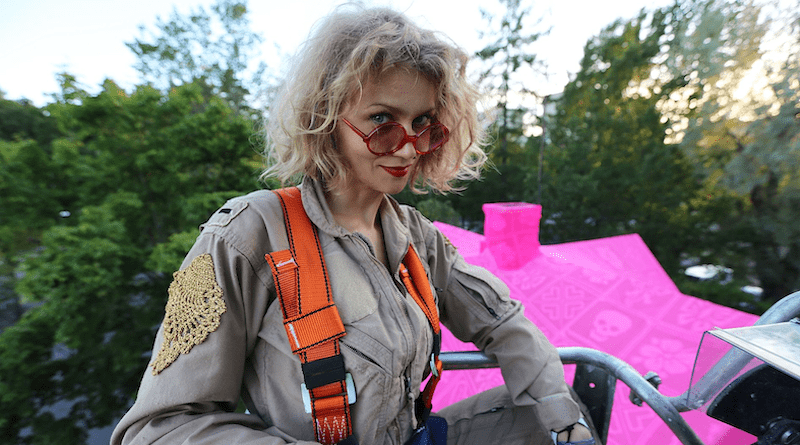Calling Macron’s Bluff, Through Art – OpEd
Like the time when French President Emmanuel Macron was elected, he made loud proclamations that there would be no more homeless people but, as usual, it was far from being true. “It was even worse, so I put him in a tent with homeless people,” says James Colomina. “Why, the homeless were delighted with the move. The site stands on the edge of the Saint-Martin canal in Paris. At first, I asked some homeless people if they would welcome President Macron with them in a tent. They told me they were delighted; So, for his birthday, I put him in a tent to shed some light on the homeless,” he added. “My intention was also to put the one who is at the very top of the pyramid, at the very bottom.”
It was in the 1970s, that graffiti artists in America successfully unionised for the first time. Between 1974 and 1980, over 20,000 artists and arts support staff secured full-time employment through Comprehensive Employment and Training Act (CETA) – making it the largest federally-funded arts project since the Works Progress Administration (WPA) created during the Great Depression, putting more than 8.5 million people to work. In New York City, the Cultural Council Foundation (CCF) launched the CETA Artists Project in 1978, with a budget of USD 4.5 million a year to fund the work of 300 artists, paying them USD 10,000 year plus benefits (nearly USD 46,000 today) to work directly with community organisations, on project teams, with performing companies, or on a wide array of public works.
Showcasing Only A Few For High-End World
Then, the wealthy responded by carefully choosing only certain graffiti artists to amplify and opened up the high-end art world selectively, incentivising street art for the sole purpose of earning money within the curated spaces set up by the elite. As a result, and inevitably, there was infighting and resentment that led to the unions eroding.
Today, the present-day continuation of excluding non-male and non-White artists from museums and the wealth associated with high-end art is no coincidence. The statistics highlight the high-brow art world as another example of the White and Wealthy very conveniently excluding those who do not “fit in” with them.
Activists like California-based Nancypili Hernandez use Street Art as a crucial tool in telling suppressed stories. Creating and directing many different murals, working in San Francisco’s Latinx community to “document people’s history that isn’t told in the history books,” it’s her work in the Mission District that highlights the struggles of the Latinx residents, amplifying the stories of a native community passed over by San Francisco’s tour guides.
In 2015, Polish street artist based in New York City, Agata Oleksiak aka Olek arrived in New Delhi in 2015 to work on a massive project and use the technique of crocheting to give expression to everyday occurrences and inspirations; her artwork often examines sexuality, feminist ideas and the evolution of communication. She visually transformed one of the 184 homeless shelters in New Delhi, to raise awareness about the lives of the desperate people who live in them. Covering the entire 40 feet long and 8 feet high structure with crocheted yarn with a team of local volunteers, she worked for seven days to put together the entire installation that was part of the ‘Rain Basera’ project.
Dressing Up A Charging Bull, At Night
Why, on Christmas Eve in 2010, she even cloaked the iconic “Charging Bull” statue on Wall Street – from horn to hoof – with a pink, camouflage-patterned cover that she crocheted herself at 3 am! It took her miles of yarn to create the fabric over ‘Six seasons of Lost‘ as she puts it. While she kept waiting for the police to stop her, they didn’t. “They were human and understood that I didn’t want to harm the statue,” but the installation lasted for merely two hours as ‘a grumpy city worker tore it down’.
Ironically, the Charging Bull itself had ‘appeared’ as a Christmas gift to New York City from Arturo Di Modica, an Italian sculptor. Di Modica, who moved to New York in the 1970s, sensing the concern and uncertainty in the United States after the crash in 1987, wanted to create a powerful symbol of the strength of the American economy.
He made plans to create a three-and-a-half ton, 18-foot-long bronze bull to reference a “bull market,” a robust stock market where share prices are rising, encouraging investors to buy more.
And, in the morning of 15 December 1989, Di Modica and a few friends parked a truck outside of the New York Stock Exchange. Within moments, they placed the bull under a Christmas tree and left.
Di Modica hadn’t expected for the bull to stay there in the long term as he thought of it as a temporary gift. And, the New York Stock Exchange, predictably, didn’t like the idea and had it removed. However, in time, it returned and went on to become one of the most visited spots of Manhattan and a hot favourite tourist destination of New York.
(This report is part of The Art Of Cause Project – a DraftCraft International initiative that documents Art Projects and Street Art campaigns that reach out, rectify and resolve strife, across the world)
Part 2 of 6 | To Be Continued

